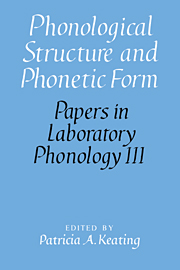Book contents
- Frontmatter
- Contents
- List of contributors
- Acknowledgments
- 1 Introduction
- I Intonation
- 2 Articulatory evidence for differentiating stress categories
- 3 “Stress shift” as early placement of pitch accents: a comment on Beckman and Edwards
- 4 Constraints on the gradient variability of pitch range, or, Pitch level 4 lives!
- 5 “Gesture” in prosody: comments on the paper by Ladd
- 6 What is the smallest prosodic domain?
- 7 The segment as smallest prosodic element: a curious hypothesis
- II Syllables
- III Feature Theory
- IV Phonetic Output
- Index of subjects
- Index of names
5 - “Gesture” in prosody: comments on the paper by Ladd
Published online by Cambridge University Press: 26 February 2010
- Frontmatter
- Contents
- List of contributors
- Acknowledgments
- 1 Introduction
- I Intonation
- 2 Articulatory evidence for differentiating stress categories
- 3 “Stress shift” as early placement of pitch accents: a comment on Beckman and Edwards
- 4 Constraints on the gradient variability of pitch range, or, Pitch level 4 lives!
- 5 “Gesture” in prosody: comments on the paper by Ladd
- 6 What is the smallest prosodic domain?
- 7 The segment as smallest prosodic element: a curious hypothesis
- II Syllables
- III Feature Theory
- IV Phonetic Output
- Index of subjects
- Index of names
Summary
Ladd's paper is a beautiful example of how experimental work can, with serious thought, be made to bear on the abstract system of phonetic rules and representations. In the case at hand, he has shown how the Gussenhoven–Rietveld effect, initially just a minor data puzzle, bears importantly on a much larger issue, that of how pitch is scaled by the system of phonetic rules.
Ladd's arguments
Ladd takes on the claim that pitch range is subject to “Free Gradient Variability”; i.e. that over a window no larger than pitch-accent size, the speaker is free to select a local pitch range. We might characterize this as positing a “beast within”; this creature monitors our speech constantly, assessing how much it cares about what we are saying at that instant, and adjusts the pitch range of our voices accordingly.
The beast metaphor should not be dismissed as absurd. For example, Bolinger (1986, 1989) has suggested quite explicit analogies between intonation and more primitive forms of vocal expression.
Ladd subjects Free Gradient Variability to three criticisms:
1. It fails to explain the Gussenhoven–Rietveld effect. When the effect occurs, listeners must interpret increases in the pitch of the first of two peaks as increases in the prominence attached to the second peak. Under Free Gradient Variability, listeners surely would interpret increases in the pitch of the first peak more directly; i.e. as increases in the prominence of the first peak.
[…]
- Type
- Chapter
- Information
- Phonological Structure and Phonetic Form , pp. 64 - 75Publisher: Cambridge University PressPrint publication year: 1994
- 1
- Cited by

